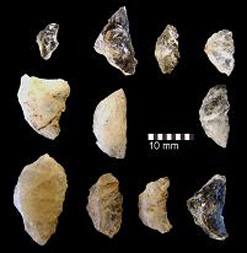
Bow and arrow invented in South Africa?
South African archaeologists have found what is believed to be the earliest evidence of human-made stone-tipped arrows, 64 000-year-old stone tools – still with traces of blood and bone – that push the development of bow-and-arrow technology back 20 000 years and throw light on humanity’s cognitive development. The finds, unearthed from layers of very […]

South African archaeologists have found what is believed to be the earliest evidence of human-made stone-tipped arrows, 64 000-year-old stone tools – still with traces of blood and bone – that push the development of bow-and-arrow technology back 20 000 years and throw light on humanity’s cognitive development.

The finds, unearthed from layers of very old sediment in Sibundu Cave in the north of KwaZulu-Natal province, were made by Marlize Lombard of the University of Johannesburg and a team of researchers and scientists under the leadership of Lyn Wadley of the University of the Witwatersrand (Wits), also in Johannesburg.
A bone point that could have been an arrow tip was also excavated from the site in 2008 by Lucinda Backwell and colleagues from Wits.
The shape of the geometric stone pieces indicated where they had been impacted and damaged, and how they were hafted, Lombard said. “This showed that the pieces were very likely to have been the tips of projectiles – rather than sharp points on the end of hand-held spears.”
In addition to the blood and bone, the arrow heads also held traces of glue in the form of a plant-based resin that the scientists think was used to fasten them onto wooden or reed shafts.

“The presence of glue implies that people were able to produce composite tools – tools where different elements produced from different materials are glued together to make a single artefact,” said Lombard.
The sophistication of the arrows sheds light on the development of human intelligence, scientists believe. According to Larry Barham from the University of Liverpool, “This is an indicator of a cognitively demanding behaviour.”
The discovery, together with other evidence, pushes back the development of bow-and-arrow technology by at least 20 000 years. The team’s findings were published in the latest issue journal Antiquity.
Ancient engineering
Scientists’ interest in early bows and arrows stems from the light the weapons shine on the technological and cognitive abilities of early Homo sapiens.
“Hunting with a bow and arrow requires intricate multi-staged planning, material collection and tool preparation and implies a range of innovative social and communication skills,” the researchers wrote in their article.
Lombard said that her ultimate aim was to explore the big question: “When did we start to think in the same way that we do now?”
“Together with additional evidence from Sibudu produced by Prof Wadley and her team, and other South African sites such as Blombos, under the direction of Prof Chris Henshilwood, we are becoming more and more confident that 60 000 to 70 000 years ago, in Southern Africa, people were behaving, on a cognitive level, very similarly to us.”
Chris Stringer from the Natural History Museum in London said the work added to the view that modern humans in Africa 60 000 years ago had begun to hunt in a “new way”.
Neanderthals and early humans, he explained, were likely to have been “ambush predators”, who needed to get close to their prey in order to dispatch them.
“This work further extends the advanced behaviours inferred for early modern people in Africa,” Stringer said. “But the long gaps in the subsequent record of bows and arrows may mean that regular use of these weapons did not come until much later.
“Indeed, the concept of bows and arrows may even have had to be reinvented many millennia later.”